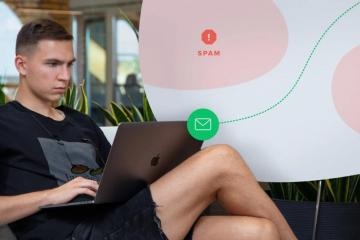
For any business, email marketing is still one of the most effective ways to boost brand awareness, strengthen customer loyalty, and drive sales. However, with so many marketers looking for ways to improve results, many myths have arisen about email best practices. Are you making assumptions that are incorrect? Whether you're a beginner or an experienced marketer, these email marketing myths may be undermining your success. To strengthen your future campaigns, here are nine common email marketing myths you can safely ignore.
Myth #1: Unsubscribes Are Bad
You don't want your unsubscribe rate to keep increasing, but a small number of unsubscribes is nothing to worry about. It may be a sign that some people aren't interested in your products or services anymore, but unsubscribes actually improve the quality of your list. After all, you don't want to be sending emails to people who don't want to see them; this will decrease engagement rates and increase spam complaints.
Think of it this way: If someone unsubscribes, even though you're delivering valuable content and competitive deals, they weren't the right customer for you. Ultimately, you're filtering out the people least likely to do business with you.
Myth #2: Millennials Are No Longer Interested in Emails
It's not true that the younger generation only communicates with brands via social media and isn't interested in marketing emails. According to one report, around 64 percent of millennials feel that email is the most personal channel to receive communications from brands (1). What's more, around 73 percent of millennials prefer to receive communication from a business via email (2). Social media is an important marketing channel, but email marketing is still a powerful tool to target young professionals.
Myth #3: Emails With Long Subject Lines Don't Get Opened
Most marketing experts recommend keeping email subject lines short, but this doesn't mean that you should avoid longer subject lines altogether. In one analysis of more than half a million emails, subject line length didn't significantly impact open rates (3).
Keep subject lines concise, but also make sure that readers understand what your email is about. Sometimes, using just a few words can lead to confusion, and people might be disappointed when they open your email and don't get what they expect.
Ultimately, the optimal subject line length depends on your industry and your audience. Longer subject lines can work well, so it's always best to perform A/B tests.
Myth #4: Using "Spam Words" Will Make Emails End Up in Spam
Despite what some people believe, using words like "free," "exclusive," and "discount" in subject lines won't automatically get your email marked as spam. Spam filters are more sophisticated than they used to be. They check elements such as the subject line, the sender's IP address and reputation, previous engagement metrics, and more.
In one study of over 500 billion emails, so-called spam words have little to no impact on deliverability (4). As long as you don't use these types of words too often and focus on engaging your unique audience, you don't need to worry too much. However, as always, track email performance to see what works.
Myth #5: Emails With Graphics Are More Engaging
Emails don't have to be filled with graphics and images to be more engaging. In one Hubspot study, emails with HTML elements had lower open rates than plain-text emails. In A/B tests, they concluded that emails with simpler designs performed better (5).
Graphics-heavy emails might look more visually slick, but they feel less personal. They're also more likely to be marked as spam. Focus on creating compelling copy that builds trust, and insert clear calls to action that align with your customer's journey.
Myth #6: Increasing Email Frequency Frightens Off Subscribers
Those new to email marketing often believe that sending too many emails will annoy subscribers and increase spam complaints. While it's true that you don't want to send three emails or more per day, you can probably send more emails than you think.
When UK insurance company Aviva increased its email sending frequency, it boosted email engagement rates and revenue per customer (6). In a report from Statista, 49 percent of consumers said they like to receive promotional emails from their favorite brands on a weekly basis, and 11 percent of respondents actually preferred daily emails (7).
There's no magic number when it comes to email frequency. The key is to focus on sending relevant and valuable email content to your prospects. If you're unsure what subscribers want, send an email survey to find out.
Myth #7: Morning Is the Best Time to Send Marketing Emails
Morning might be the best time to send some of your emails. However, optimal send times vary according to your industry, your audience, the type of email being sent, the time of year, and many other variables. For this reason, there is no universal answer to the question of when to send an email. The best way to find out what works for your business is by experimenting and tracking the results.
A/B testing send times is the best way forward. For example, split-test two emails containing the same content, but deliver the emails on different days of the week, or different times of the day. By measuring open rates and conversion rates over time, you'll begin to discover what works for your unique audience.
Myth #8: Inactive Subscribers Should Be Removed from Your List After Six months
A certain percentage of email subscribers naturally become less engaged with emails over time. However, you shouldn't remove subscribers from your list just because they've been inactive for several months.
Studies have shown that 20 percent of "inactive" subscribers will open an email after six months (8). It's therefore a good idea to be more patient before you clean your list. Before removing "inactive" subscribers, ask them to update their email preferences, or offer an incentive such as a discount to reignite their interest in your brand.
Myth #9: Email Marketing Is Expensive and Time-Consuming
There are plenty of affordable and even free email marketing tools that allow you to quickly and easily create, personalize, and optimize your emails. Most tools also have automation features that save time and effort. For example:
- Automatically send an email when a subscriber takes a specific action.
- Customize pre-made email templates.
- Track the performance of an email campaign.
- Segment your list according to multiple criteria.
Final Thoughts
Email marketing is still one of the most effective forms of digital marketing today, but many marketers rely on email "best practices" that are no longer valid or have always been questionable. Hopefully, this summary of email marketing myths encourages you to question the status quo and rethink some of your strategies going forward.
Ultimately, the best way to strengthen your email campaigns is to look at your own data for answers, test different strategies, and track the results. You can then discover what works best for your unique audience and make sure email marketing supports the growth of your business for years to come.








